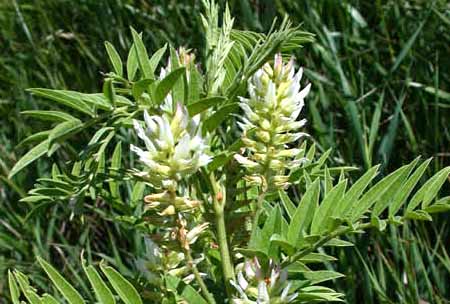Wild licorice is an easy native perennial to grow with showy pale yellow to white flowers. Due to its long taproot and tough root system it is often employed to stabilize banks and other areas where subsidence may be a problem so long as the area gets some moisture. While tough this plant is not drought tolerant. It can take full sun and grow to zone 3. Once established it takes very little care or maintenance. The roots can be dug up and eaten like sweet potatoes or enjoyed for their sweet taste.
Description of American Licorice (Glycyrrhiza lepidota).
Wild licorice is a tough native perennial herb hardy to zone 3a down to 10b.
In spring it sends up stout stalks with leaves arranged alternatively. The leaves
are compound, mid green in color and consist of 11-19 lance shaped leaflets
arranged in pairs on the stem. Leaves can grow up to 8" (20 cm) long with
individual leaflets being up to 1 1/2" (3.8 cm) long; leaves have small
scales when young but as they age they change to sticky resinous dots that are
aromatic. Plants can range from 3' tall in warm zones to only 18" in cooler
zones. In summer flower stems arise from the middle and upper branches. Flowers
are small and grouped into spikes of 10-20 with each pea-like flower being whitish
yellow and about ½" (1.3 cm) long with the whole spike being 2 -
3" (5 - 8 cm). Flowers in the spike bloom at different times so blooming
lasts about a month. Flowers are followed by stalkless dark brown to reddish
brown seed pods which are covered in hooked bristles.
The plant has long tough taproots and interconnecting crowns making it a very
hardy plant, that can fix its own nitrogen.
Location and Care of American Licorice (Glycyrrhiza lepidota).
American licorice has very long deep taproots so it does not take well to being
transplanted. Ensure that the location you choose is where you want it to stay
because moving it will be difficult. It is very adaptable in soil types and
although it prefers a sandy soil it will grow well on almost anything provided
it has enough moisture. This is NOT a drought tolerant plant but once established
it can tolerate soils drying out somewhat. It prefers to have good organic material
in the soil. In most cases adding good amounts of organic material to the soil
will make it suitable and it will hold more moisture and change the ph. American
licorice can tolerate a fair range of pH from 5.5 to 8.
Wild Licorice prefers full sun and it is really needed in lower zones (3 -5)
It can tolerate a little shade in 6-7 and will need more shade in higher zones.
Best to have morning and/or afternoon shade but some shade at noon in hotter
zones.
Placement and care is going to depend therefore on your zone. Low zones can
tolerate less moisture and more sun, higher zones needs some shade and more
water to accommodate the heat. Organic material is needed in all cases for a
good establishment of your plants.
Once established apart from a little water American or Wild licorice needs very
little care and attention. Wildlife does like the plant so some protection will
be needed if they are a problem in your area.
Because American Licorice has such tough long deep roots it can be used to stabilize
disturbed sites and is excellent for banks, slopes and other possibly unstable
areas provided it has some moisture. It will not do well if the slope is dry.
Growing American or Wild Licorice (Glycyrrhiza lepidota) from seed.
A fairly easy plant to grow. Pre soaking the seeds for 24 hours is said to promote
better germination. Sow indoors in early spring in individual cell trays, small
pots or flats. Transplant to larger pots and grow on until large enough to plant
out. See
general growing instructions
for more details on starting seeds.
When planting out to their final location make sure that the whole pot of soil
is moved with the plant. It does not like having its tap root disturbed. Moving
plants after they are established can be difficult and often not successful.
Problems with Wild or American Licorice.
The plant has few problems with disease or insects but it is enjoyed by wildlife.
Deer, pronghorn antelope and rabbits will eat the leaves, birds and small rodents
will eat the seeds. Voles will eat the roots. If any of these are a problem
in your area the plants will need protection.
Edible Uses of Wild or American licorice (Glycyrrhiza lepidota).
Roots are long, fleshy and sweet. They can be slow roasted and used like sweet
potatoes. Roots contain 6% glycyrrhizin which is 50 times sweeter than sugar
so it makes a nice 'candy' for children and adults alike. Can be used alone
or as flavoring in other foods.
Medicinal Uses of Wild or American licorice (Glycyrrhiza lepidota).
The roots are the active part of the plant and can be used as a substitute for
common licorice (Glycyrrhiza glabra) although it has less active ingredients
so larger dosages will be needed. It is used in a range of diseases including
diarrhea, chest pains, fevers in children, stomach aches as well as stabilization
of hormone levels from the adrenal glands. It is also used to help speed the
delivery of the placenta after childbirth. Chewing on the roots can help reduce
toothache and sore throats. The leaves are sometime mashed as a poultice for
treatment of sores or earache. Whole leaves can be placed directly in the shoes
to absorb moisture.
Caution. Very young growth can be poisonous to animals.







